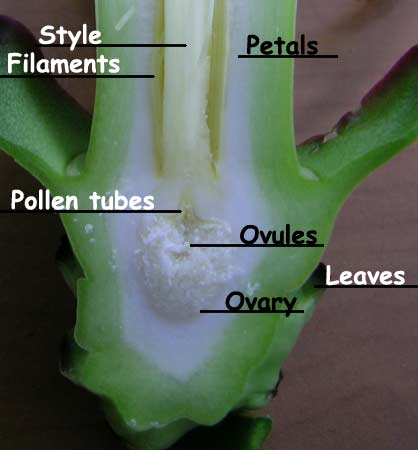
Cacti Flower AnatomyMost cacti have epigynous flowers; inferior ovary. There are 2 kinds of ovary, inferior an superior ovaries. In some flowers the petals, sepals and stamens are all attached to a receptacle beneath the gynoecium (term for all the carpels, or female reproductive organs). With Superior ovaries the ovary is above the other floral attachments. With cacti flowers (except some Pereskia), the floral tube is fused to the ovary, petals and sepals. The stamens look like they are coming out from the top of the ovary. The ovary is located below the other floral attachments. In very very basic terms without straying too far form cacti:Cacti have an inferior ovary-hypogynous Ovary is located below other floral attachments (petals, sepals and filaments). Only some Pereskia have a superior Ovary-epigynous Ovary is located above the receptacle that the other flower parts attach to (petals, sepals and filaments). Cacti pollination mechanism is called Entomophilous, meaning they use things like insects, birds bats etc to move pollen; unlike Anemophilous flowers which use the wind to move pollen. Basic Flower Anatomy
Flower cross section by the ovary.
Anther: Anthers are the objects that hold the pollen. They are placed on top of the filaments which hold them up. Some species use environmental factors such as wind to disperse the pollen, so the pollen is fairly light weight and easily let go. In the case of cacti, the flower uses insects and other animals to carry the pollen away and generally needs to be rubbed or brushed against for the pollen to be released. Filament: The filament is the stem like structure that holds up the anther. Sometimes the filaments are very long, protruding right out of the flower, others are short and seemingly hidden. Sometimes with cacti, when the stamen is touched or blown on, they will curl in towards the stigma or style. Leaf primordia: The first appendage primordia in cacti are in leaf primordia . Usually the leaf primordia develop more on the flower stem than they do on the rest of the plant (with cacti). Ovary: The ovary is the place where all the ovules (think "eggs") are kept. When the pollen lands on the stigma and travels down the style it reaches the ovary where it goes in and fertilizes the ovules. Ovule: Ovule is in very non-scientific terms the "egg". The pollen will travel down to the ovary where it meats the ovules and fertilizes them. Once fertilized, they will become the egg. See photo Perianth: A collective term for the sepals and petals. Pericarp: The pericarp is what protects the seeds in the fruit. There are 3 layers to the Pericarp as seen below. See photo. 1. Exocarp: The outermost layer of the pericarp (peel/skin). See photo. 2. Mesocarp: The middle layer of the pericarp, often what we see as a fleshy fruity area. The part we eat on the peach, the "fruit", is the mesocarp. See photo. 3. Endocarp: The inner most layer of the pericarp. Often a thin film or paper like layer around the seed. In cacti this is often jelly like. See photo. Petals: The showy arrangement often enveloping both male and female parts. This is often what attracts animal pollinators to the plant via colour and scent. Pistil: Pistil is a collective term for the stigma, style and ovary. The pistil is the female reproductive unit. Pollen tube: When pollen lands on the stigma it will, hopefully, germinate and start to grow a pollen tube. One *could* visualize this as a seed (pollen) landing on the ground (stigma) and germinating and sending down a root (pollen tube). The pollen tube is how the pollen gets the sperm down to the ovules via the style. Stamen: Stamen is the collective term for the filament and anther, male reproductive unit. Stigma: Stigma is located at the top of the pistil on top of the style. The stigma is usually sticky and is specialized in catching the pollen when it lands. When the pollen lands on the stigma, it germinates and sends down a pollen tube to the ovary. Style: The style is the stem like structure that holds up the stigma. As well as support the stigma, the style helps direct the pollen tube to the correct place at the ovary. Think of it as "pollen highway to the ovary". 
Astrophytum mysriostigma flower macro. | ||||||



